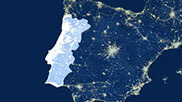

The prolonged periods of droughts and the heatwaves of this summer, resulting in widespread wildfires as well as flash floods underline the need for increasing the resilience of electricity grids.
Considering the Climate Change induced challenges, the current fossil fuel supply crisis is just part of the driving force to electrify our economy and make grids future-proof.
EU-funded research projects point out cost-efficient solutions to cope with grid resilience amidst such extreme weather events and fast-increasing electricity demand.
Climate change increases the frequency and severity of extreme weather events, which also include storms and cold waves, and affects multiple sectors. This could lead to systemic failures and power outages across Europe.
This summer, water reservoirs throughout the continent experienced severe level decreases due to the combined effect of draughts and the efforts by system operators to maximise the use of cheaper renewable hydropower generation to satisfy increasing electricity demand.[1] However, also distribution grids are affected, for example, this July in London several fires cut power lines for regional electricity supply while demand was peaking due to the use of air conditioning devices. At the same time, prices in Belgium rose to record levels, forcing the British system operator to pay record charges to avoid a blackout by importing energy. Therefore, climate change must be accounted for in grid planning.
As extreme weather events increase in frequency and severity, the secure and reliable operation of distribution grids is affected.
The recent heat waves are infamous examples of extreme weather events, whereas a heat wave is usually considered three days in a row with temperatures that are higher than their respective 90th percentiles from the historical period.[2]
However, as shown with the figure below, also the number of other extreme weather events will rise and put constraints on electricity supply.[3] Therefore, the ability of grids to cope with such gradually normal weather events must be improved.

Electricity grids are central to supplying consumers with power and utilising distributed energy sources, as reiterated by the REPowerEU strategy.[4]
European climate policies drive overall electrification and, while final energy consumption remains steady, aim at doubling the share of energy demand covered by electricity from the current 25% to more than 50% by 2050.[5] Hence, an additional supply of about 4,000 TWh would be necessary, the equivalent of Europe’s current total electricity consumption in 2019.
Part of the electrification is driven by heat waves; a further uptake from 110 million cooling units in 2019 to 275 million units in 2050 is expected since the number of cooling degree days already tripled between 1979 and 2021.[6]
Devices like this but also additional distributed, renewable energy sources put the connected distribution grids at the centre of the current transition. Therefore, amidst climate change and the Green Transition, resilient electricity grids are key to the functioning of the power system.
Electrification is central on the road toward climate neutrality and diversifying the energy supply but drives the need to focus on the resilience of distribution networks.
Finding solutions to these challenges, like adding distributed energy sources, mobile, and flexible energy resources, and hardening infrastructure, is significant.
Distribution system operators are constantly working on increasing the resilience of their grids by exploring multiple pathways. Overall, it is estimated that distribution system operators require about €400 billions of additional investments until 2030 to maintain and modernise electricity grids.[7] However, the final products and toolkits of innovative research projects could enable system operators to elevate the efficiency and flexibility of current grids, postpone additional infrastructure investments, and reduce possible downtime of electricity networks.
The EUniversal project specifically explores resilience issues, as highlighted by recent extreme weather events.
With the system operators E-REDES, Energa, and E.ON with MitNetz, INESC TEC and the University of Cyprus, the project is looking into planning tools for predicting, assessing, and quantifying the impact of extreme events on distribution grids as well as the identification of new automation and control strategies taking advantage of flexible resources to improve the system response. These include spatial and temporal event simulators for predicting and quantifying the stochastic impact of extreme events, multi-objective planning tools for ensuring trade-off informed and robust investment planning, optimization algorithms for the optimal dispatch of mobile energy sources in the face of an extreme event and islanding strategies considering the grid support of flexible resources.
Preliminary results already demonstrate the efficiency of these tools in reinforcing the flexibility and resilience of distribution networks against extreme weather events. In fact, the simulation tool CIPROS (“Capital Investment Planning for Resilience Optimization of Smart Grids”) developed by the team of University of Cyprus (Mathaios Panteli, Mohamed Lotfi, and Balaji Venkatasubramanian) has been selected amongst the top 12 innovative products from EU-funded projects in the 2022 Innovation Radar Prize competition by the European Union and Dealflow.eu.
Electricity grids must be ready for Climate Change induced challenges, such as the heatwaves of this summer and the increasing electrification. Innovative projects like EUniversal implement mechanisms that enable the active participation of additional renewable energy sources and account for climatic challenges that are more and more going to be part of our daily lives. Network infrastructure must become stronger and more efficient.
Creating resilient grids with the help of innovative planning tools is essential to be prepared for changing circumstances.





